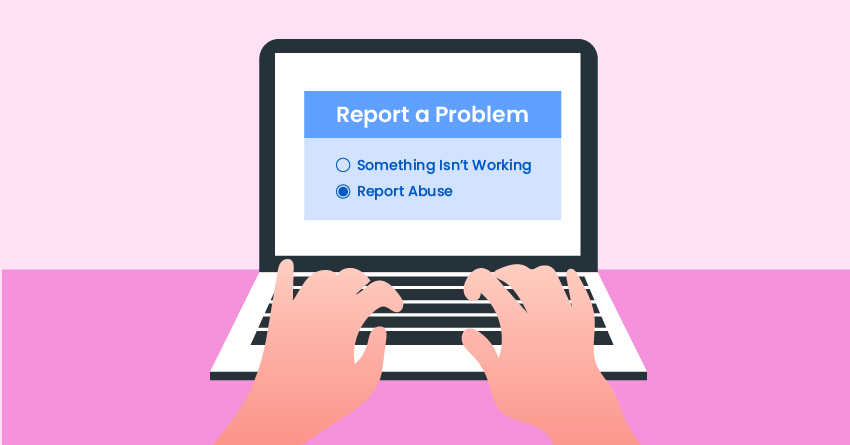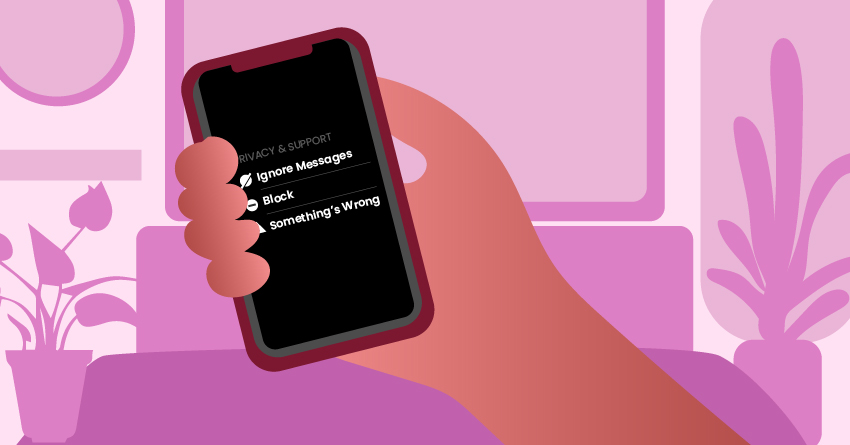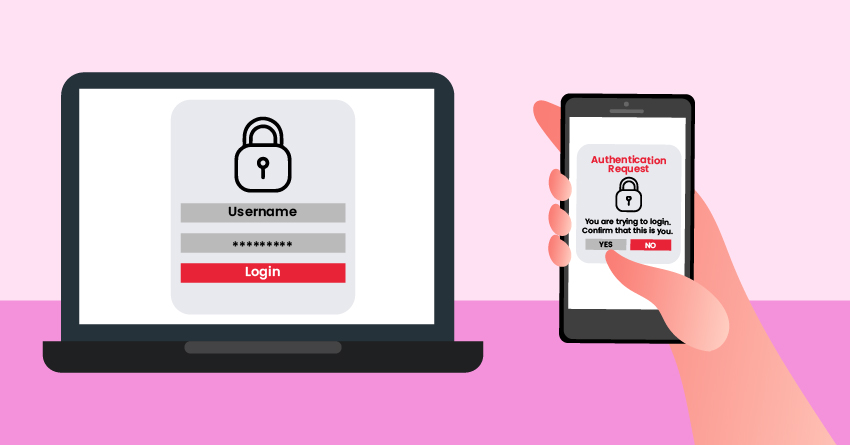
Trigger Warning: This blog post discusses online sexual harassment and abuse.
Social media used to be a novelty tech that people used for fun. We create casual profiles, share corny jokes, and post photos of our awkwardly-filtered selfies.
But as of today, social media has become a crucial part of our daily lives. It has become our public space, source of news and entertainment, the main channel to communicate with loved ones, a marketplace to get essential items, a space to get jobs, and even a place to launch a business.
That’s why we’ve become dependent on it. Reports from advertising firms such as We Are Social and Hootsuite have shown that the Philippines has the longest usage time for social media. Filipinos spend an average time of 4 hours and 15 minutes each day on social media platforms such as Twitter and Facebook— and it’s all because of the convenience and instant gratification that it brings to our lives.
But along with the benefits that we could get from social media, there are also tons of dreadful things that we may experience in it.
Social media can also serve as an avenue for online sexual harassment. Just over the past decade, online activities such as “doxxing,” “revenge porn,” “unwanted sexting,” “sextortion,” “cyber flashing,” and “zoom bombing” have emerged in the virtual space. Someone’s life and reputation can be instantly ruined because of these horrific activities.
That’s why it’s vital to prepare ourselves for possible online sexual harassment. We need to learn how to deal with it and how we can report the violators. It’s also essential to learn the necessary steps to protect ourselves and our loved ones from these vile perpetrators.
For this guide, we will be discussing the steps you can take when dealing with sexual online harassment. We’ve also prepared a brief section about ways to protect yourself against online abusers and trolls. But before we proceed on the main topic, let’s learn what online sexual harassment is all about.
What is Online Sexual Harassment?

As quoted from the national sexual violence resource center (NSVRC), it can be any type of sexual harassment, exploitation, or abuse that takes place through screens. Basically, it’s an unwelcome sexual behavior online that’s intimidating, offensive, and humiliating. It comes in various forms such as the following:
- Receiving unwanted or hateful comments based on sex.
- Receiving provocative photos or videos from partners or strangers without your consent.
- Seeing unwanted sexual acts through video call or Livestream.
- Experiencing revenge porn— having your intimate photo or videos being shared online without your consent.
- Getting zoom-bombed, wherein a stranger would bombard a zoom meeting and share graphic videos in it.
- Experiencing sextortion— being forced to give money or provide sexual favors from the perpetrator because they have evidence of your sexual activity, such as nudes.
- Being groomed online— children being manipulated by adults with the intent of sexually abusing them.
The mentioned forms above just represent a fraction of the ways that consent can be violated online. Now, as these activities are done virtually, there’s a misconception that it’s “not as difficult” as physical forms of sexual harassment, such as groping, assault, and rape. Even if online sexual harassment just happened behind a screen, the victim’s impact is just as harmful as a physical one.
How to Deal With Online Sexual Harassment
If you’re going through online sexual harassment, we get that it’s not easy to just “deal with it” as the abuse may leave feel threatened and powerless. But keep in mind that managing the trauma, speaking up, and reporting the crime— this is how things turn around. Gathered from various resources and experts, here are the necessary steps to deal with sexual abuse online.
1Find the courage to stand up.

Most victims of online sexual harassment tend to stay silent due to fear of being judged by their family and peers. They don’t want to deal with the stress and shame of reporting the said crime to the authorities. However, staying in the shadows will only make the abuser win. If the perpetrator’s actions aren’t reported or exposed, this vile person will continue abusing other unsuspecting victims.
This is why for our first step, we urge you to find the courage and speak out against the harassment. We know it’s never easy, but this is the only way to turn things around. You don’t have to do it right away, but do it once you’re ready to fight.
Now, speaking up doesn’t mean you should automatically expose the violator through social media. Legal experts say that this could negatively impact the case and may even be used against you. It’s best to start speaking up by telling your loved ones about the incident and reporting the perpetrator to the authorities.
And once the reports have been filed, you can start sharing your story and expose your perpetrator’s wrongdoings— just be mindful with the words you’re using as you don’t want to trigger other victims.
-
₱9,000.00
-
Original price was: ₱1,845.00.₱1,476.00Current price is: ₱1,476.00.
-
₱4,745.00
-
₱4,745.00
2Seek support from friends and family.

Besides managing the trauma that one might experience after online sexual harassment, another difficult thing to do during this period is to tell your loved ones about the harassment. However, this is a crucial step when dealing with online abuse. You may be overwhelmed with the pain and shame that comes with the harassment, so you’ll need a support group that could help you through this period.
Now, you don’t have to rush this process. Just share your story once you’re ready. You don’t also need to share it with your biological family— if you’re more comfortable telling it to your closest and trusted friends, then do just that. You can also reach out to a mental health professional for support.
3Document the evidence of online sexual harassment.

It’s vital to keep screenshots or video clips of the incident. Save the soft copies on a cloud-based drive and also keep a hard copy. You may need these screenshots as evidence of the said abuse. We also suggest asking a trusted friend to keep tabs and screenshots of public posts that are being shared by the perpetrator— your friend can also be a witness for the crime.
4Report the posted content (if there’s any) to the involved sites and social media platforms.

If you’re a victim of revenge porn or similar activities to this, report the content on all the involved social media platforms and websites (after taking screenshots).
Suppose you’ve discovered your intimate content on large social media platforms such as Instagram, Facebook, or Reddit, or on large pornography websites such as xhamster or pornhub. In that case, you can report the photos or videos on those sites for violating user guidelines.
Cyber Civil Right Initiative (CCRI) has published a detailed guide on reporting and removing your violated content on these websites; click the guide here to learn more about the proper steps.
As for cyber flashing victims (receiving genital photos without your consent) or unwanted sexting, you may report the accounts on social media platforms. Here’s a detailed guide on how to report the perpetrator on the involved soc media platform.
5Stop engaging with the harasser.

Most online sexual harassment victims do, once they’re received the harassment is by responding directly to the violator. They would send countless messages about what they’ve done, trying to manage the situation.
However, engaging with your harasser may only escalate the abuse. Some violators are also trolls, which means they enjoy getting a negative reaction from you. That’s why instead of giving them the engagement that they want, just block or mute them on your social media accounts and only ask a few trusted friends to check and keep tabs on the abuser’s account.
Just focus your energy on taking the proper steps on reporting the violator— removing some of the triggers (such as seeing the messages of the perpetrator) will help you manage the trauma caused by the said abuse. You can also speak out about the abuse that has happened— but then again, do this once you’re ready and be cautious with it.
6Assess your safety.

As you prepare the necessary documents to report the violator, take some time to assess your own and your loved ones’ safety. This is vital as the abuse online may happen in real-life if things may escalate. So start assessing the threat by asking yourself these questions.
- Is the abuser someone you know, or is it an anonymous individual?
- Does the abuser have a history of violent behavior?
- Have you been threatened by the abuser?
- Does the violator have your email, address, and phone number?
- Does the perpetrator have migrated across platforms or moved offline? Do they start sending your packages, voicemails, or even letters at your workplace?
- Are your closest friends and family getting harassed by the abuser?
If the online sexual harassment has made you feel unsafe in any way, it’s best to relocate temporarily to a hidden location, such as a hotel room, new apartment, or a friend’s house. We also suggest reporting to law enforcement and apply for a protection order— this safeguards you from further harm. If family and friends are involved in the threat, make sure to keep tabs on their whereabouts.
-
₱150.00
-
₱285.00
-
₱1,499.00
-
₱7,530.00
7File a case against the perpetrator.

Go with a loved one and a legal counsel to the PNP Anti-Cybercrime Group (PNP ACG). It’s the National Operational Support Unit of the PNP is primarily responsible for implementing pertinent Philippine laws on cybercrime. Report the online sexual harassment against the perpetrator as it has legal implications under Philippine Laws. Below is the brief summary of the said laws:
Republic Act 11313: Safe Spaces Act
If you’re experiencing gender-based online sexual harassment, this is generally the law that you can file a case into. The Republic Act 11313, also known as the Safe Spaces Act and the “Bawal Bastos Act,” addresses the existing gaps and issues in equality, safety, and security of both women and men in private and public, and online spaces.
As stated in article 2 – section 12 of this republic act, gender-based online sexual harassment is punishable by law: It includes the following online activities:
- Terrorizing and intimidating victims through physical, psychological, and emotional threats, unwanted sexual misogynistic, transphobic, homophobic, and sexist remarks and comments online, whether publicly or through direct and private messages.
- Invasion of victims’ privacy through cyberstalking and constant messaging, uploading and sharing without the victim’s consent, any form of media containing photos, voice, or video with sexual content.
- Any unauthorized recording and sharing of any of the victim’s photos, videos, or any information online.
- Impersonating identities of victims online or posting lies about victims to harm their reputation.
- Filing false abuse reports to online platforms to silence victims.
As you report the violator under this RA11313, you may be given a protection order, directing the perpetrator to stay away from you at a distance specified by the court or to stay away from the residence, school, place of employment, or any specified place that you frequented (article 6, section 27).
The perpetrator may face two years up to four years and two months in prison if proven guilty. There’s also a fine of P100,000 up to P500,000.
Republic Act No. 10175: Cybercrime Prevention Act of 2012
Being coerced or forced to do cybersex is punishable by law. According to the section C-1 of RA 10175, having “the willful engagement, maintenance, control, or operation, directly or indirectly, of any lascivious exhibition of sexual organs or sexual activity, with the aid of a computer system, for favor or consideration.” is a punishable act.
If proven guilty, the abuser may face imprisonment of six to twelve (6-12) years. There may also be a fine of at least P200,000 up to P1,000,000.
Republic Act No. 9995: the Anti-Photo and Video Voyeurism Act of 2009
If you’re a victim of revenge porn, you can sue the perpetrator with Republic Act. No. 9995. This law prohibits taking photos/videos/recordings/ of people performing sexual acts without consent. It also bans reproducing, selling, distributing, publishing, broadcasting, and exhibiting the said content on VCD, DVD, internet, phones, and other similar means or devices.
If proven guilty, the perpetrator may face three to seven (3-7) years of imprisonment. There’s also a fine ranging from P100,000 to P500,000.
-
₱11,990.00
-
₱12,600.00
-
₱4,750.00
-
₱12,645.00
8Take a break from social media and practice self-care.

As much as it’s important to share your narrative and voice out your story, it’s also important to take care of your mental health during this difficult time. We suggest logging off every now and then and focus on other things. Meet up with your friends, engage in new hobbies, get some new books, travel with friends— do the things that make you happy.
We know that dealing with online sexual harassment can be demoralizing and threatening. There’s also a sense of shame as there’s still a stigma regarding sex scandals and similar content in the Philippines. If you’re not ready to tell your story to the public, it’s okay. Take the time to prepare yourself. We also suggest seeking professional help to guide you towards healing.
How to Protect Yourself Against Online Sexual Harassment
Though online sexual harassment isn’t fully preventable, as some anonymous as*holes are still scouring the internet, there are ways to minimize the damage it can bring to your life.
By taking the necessary steps in bolstering your cybersecurity, as well as equipping yourself with the right information, you’ll be able to save a harassment incident from escalating. Here are ways to protect yourself against sexual abuse online.
1Never share social media passwords with your partner.

There’s a dating trend within couples, particularly the younger ones, wherein they give passwords to each other. Some even consider it as taking the relationship to the next level, as you’re giving full trust to your partner.
However, this is incredibly risky, as if things get messy in the end, your partner might use the information on your social media account against you. Now, we’re not saying that your partner is a scum, as not all password-sharing cases end up in online sexual harassment. We’re just warning you should be cautious when sharing one. And once you’ve broken up, change your social media passwords immediately.
2Set up two-factor authentication for your personal and professional accounts.

For those unfamiliar with the term, two-factor authentication provides an extra layer of security, ensuring that people trying to gain access to your account wouldn’t be able to do so. After inputting your username and password, the person will be required to provide another piece of information— it could be a unique one-time passcode (OTP) from your phone or an answer to a secondary question.
By having this advanced feature on all of your social media accounts, you can assure that only you will access those accounts.
-
₱150.00
-
₱150.00
-
₱150.00
-
₱150.00
3Be wary of the content you send and the platform you use when sending intimate photos.

There’s nothing wrong with sending some steamy messages, photos, and videos to your partner. However, as we’ve mentioned earlier, those intimate content may be used against you.
That’s why when sending sexual content, it’s best to keep it lowkey— no photos of your face and no obvious background detail of your room. We also suggest using messaging platforms that allow time-based message destruction or disappearing photo features. Look for messaging apps that notify you if someone’s taking a screenshot.
4Educate yourself and your loved ones about consent.

Besides protecting yourself, it’s also essential to share information about consent and online sexual harassment with your loved ones. Explain what informed consent is and why it’s important in every activity that you do online. This strengthens their safety from online abuse.
5Raise awareness regarding online sexual harassment and how victims can take a stand.

Aside from sharing your narrative, we also suggest sharing infographics, articles, and other helpful resources about sexual harassment. Encourage other people to share these resources. We also suggest supporting organizations that are against online sexual harassment, such as End Rape Culture PH.
Takeaway
Sexual abuse falls within a spectrum of behaviors, one of which is online harassment. The abuser may not be physically involved with the survivor, but it creates long-lasting trauma. That’s why resources such as this guide must be shared; we need to encourage more people to fight against it.
As for the steps that we’ve shared in this guide, you don’t have to follow each step, let alone in order. It’s up to you if you want to skip certain steps or just combine them in one huge step. We know that it will never be easy to deal with such a horrific act, so take a deep breath and sort things out at a pace that you’re comfortable with.
In line with Sexual Assault Awareness Month, we hope that this guide has helped you deal with and fight against online sexual harassment. It’s time for the survivors to take a stand— let’s work together on building safe spaces online.
-
₱0.00 – ₱175.00
-
₱169.00
-
₱50.00 – ₱195.00
-
₱985.00






















